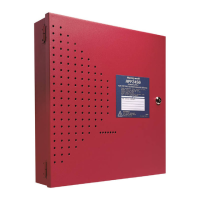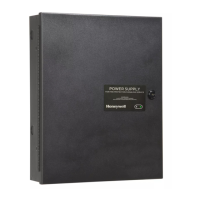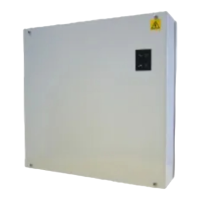20 HPF24S Series Power Supplies — P/N 52751:E1 4/14/2011
Programming Options DIP Switch Settings
3.1 DIP Switch Settings
The following table lists the HPF24S programmable features and the switch settings required to
select a particular feature. A detailed description of each feature is presented in the following
pages.
SW1 DIP Switch ON OFF
1 This switch works in conjunction with switch 2 to determine the Strobe Synchronization Type
1
.
2 1 OFF, 2 OFF = no sync (steady +24V) - default
1 OFF, 2 ON = System Sensor
1 ON, 2 OFF = Gentex
1 ON, 2 ON = Wheelock
3 FCPS configured for Slave Synchronization FCPS configured for Master Synchronization - default
4 Delay AC Fail Reporting for 2 Hours - default
Aux. Trouble Relay responds to all troubles
Internal Trouble contact responds to AC loss
No Delay in AC Fail Reporting
Aux. Trouble Relay responds only to AC Fail/Brownout
Internal Trouble contact does not respond to AC loss
5 This switch works in conjunction with switch 6 to determine Input to Output functions
6 5 OFF, 6 OFF = General Alarm - default
• FCPS configured as Master (switch 3 OFF), NAC Outputs 1 through 4
2
are controlled by Control Input #1;
Sync Input is ignored.
• FCPS configured as Slave (switch 3 ON), NAC Outputs 1 through 4
2
are controlled by Control Input #1;
Sync Input is monitored
3
.
• Resettable or nonresettable Auxiliary Power Output is available from TB4 Terminals 9 & 10. Control Input
#2 determines if reset will occur (must go from On to Off for a minimum 6 second reset to occur).
• Output #4 function follows DIP switch 8 setting.
5 OFF, 6 ON = Split Alarm
• FCPS configured as Master (switch 3 OFF), NAC Outputs 1 & 2 are controlled by Control Input #1 and
Outputs 3 & 4
2
are controlled by Control Input #2; Sync Input is ignored.
• FCPS configured as Slave
4
(switch 3 ON), NAC Outputs 1 & 2 are controlled by Control Input #1 and
Outputs 3 & 4
2
are controlled by Control Input #2; Sync Input is monitored
3
.
• Only nonresettable Auxiliary Power is available from TB4 Terminals 9 & 10.
• Output #4 function follows DIP switch 8 setting.
5 ON, 6 OFF = Split Temporal
• FCPS configured as Master (switch 3 OFF), Control Input #1 controls NAC Outputs 1 & 2 and Control Input
#2 controls Outputs 3 & 4
2
which will generate a Temporal code signal without sync; Sync Input is ignored.
• FCPS configured as Slave (switch 3 ON), Control Input #1 controls NAC Outputs 1 & 2 and Control Input #2
controls Outputs 3 & 4
2
which will generate a Temporal code signal without sync; Sync Input is monitored
for Outputs 1 & 2
3
.
• Only nonresettable Auxiliary Power is available from TB4 Terminals 9 & 10.
• Output #4 function follows DIP switch 8 setting.
5 ON, 6 ON = Selective Silence
• FCPS configured as Master (switch 3 OFF), NAC Outputs 1 through 4
2
are controlled by Control Input #1;
Sync Input is ignored.
• Control Input #2 determines when Selective Silence for all outputs will occur
5
• Only nonresettable Auxiliary Power is available from TB4 Terminals 9 & 10.
• Output #4 function follows DIP switch 8 setting.
7 Disable Charger Enable Charger - default
8 Output Circuit #4 = Door Holder Output Circuit #4 = NAC - default
Table 3.1 DIP Switch Settings
1 Strobe Synchronization only works with non-coded NACs.
2 If Door Closer function is selected (switch 8 ON), Output 4 does not function as an NAC, therefore sync input is
ignored for it.
3If no synchronization is selected by switches 1 & 2, the Sync Input is ignored.
4 When using Split Alarm with power supply configured for Slave Mode, System Sensor cannot be used (use
System Sensor with Master Mode only).
5 Selective Silence allows the silencing of the sounder portion of a horn/strobe combination device without turning
off the strobe.

